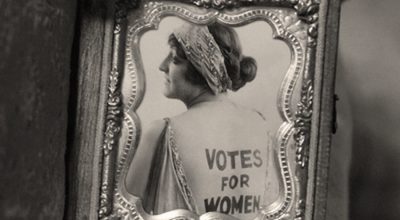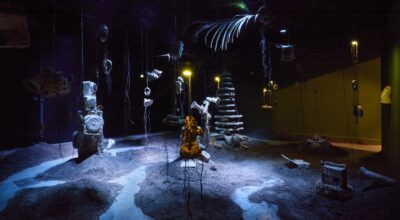
CLAUDIA MARTÍNEZ GARAY: GHOST KINGDOM
In Ghost Kingdom, Claudia Martínez Garay (b. 1983 in Ayacucho, PE) continues her ongoing investigative practice of history and memory in her home country of Peru concerning racism, war, social prosecution, and the legacies of colonialism toward the Andean people. Martínez Garay creates a body of work that articulates a powerful auto-narrative of a culture constantly mediating its interrupted pasts.
In Preguntitas a la Tierra (Little questions to the Land (Ground, Soil, Dirt), pamphlets distributed as propaganda between the1970’s to the 1990’s in Peru and its surrounding region are appropriated and reconfigured. Martínez Garay interrogates this circulation of media by collaging these signs in juxtaposition to each other, forming a landscape that re-appropriates their methods of signification to describe many commonalities felt throughout Latin America, left in the aftermath of colonialism, religious upheaval, dictatorship, guerrilla warfare, and civil war.

In her recent Pacha works, symbols of Andean cosmology, native cultures of Peru, ethnographic journals, western chronicles of the land, and personal history are physically woven together. These multi-temporal visual gatherings -at times deeply introspective, at others anthropological- are charged with symbolism. This ongoing series reflects on time and its passing, complicating our understanding of what constitutes a historic document, and seeks to defy linear time. For the artist, these seven new textile works animate flashbacks through time, where the gaps in personal and collective history are often masked in the long durée of political upheaval.
In a series of new sculptures, academic drawings of native flora from the South American region are printed on aluminum panels and placed throughout the gallery. Transformed out of their anthropological context, these works form an uncanny terrain where their flat imagery emphasizes the alien means of their documentation and questions the history of categorization, which affects our ideas of their natural belonging.




The artist also presents Ayataki (2022), a new animated video and surround sound installation, commissioned and produced by Artpace, San Antonio, and the Denver Art Museum in Denver, CO (US). The video-sound installation recently debuted in Who tells a tale adds a tail: Latin America and contemporary art, currently on view at Denver Art Museum. Through visualsand a collaged original score, reinterpreted with a synthesizer by the artist, Peruvian Andean folkloric music is intertwined with Quechua church melodies, radio transmissions, Spanish dialogues, sorrowful voices, pan-flutes, raging guitars, and radio commercial propaganda to relay a tale of forced displacement due to violence and war. The radio tower, the bomb cars, and burned rural houses- often targeted by the terrorist group Shinning Path during the internal war in Peru have become symbols of terror, loss, and despair of that time. This work as a whole is a lamentation on the Andean landscape. Social issues and historical events are presented in a nonlinear narrative, and the mixed poetic and formal composition of sound constructs a solemn funeral cadence which sonically reflects a mourning for those who did not survive the war.
Throughout all of Ghost Kingdom Martínez Garay shows that recorded history and media, although divisive, can -and has been-reclaimed by the people of Peru and its surrounding regions. Claudia Martínez Garay’s striking installation practice, brilliant use of color, and varied configurations of scale and material reminds us of the importance of collective mythologies in reclaiming symbols of the past through alternative methods of storytelling practiced throughout South American communities to challenge hegemonic colonial narratives and propose alternative futures.

CLAUDIA MARTÍNEZ GARAY: GHOST KINGDOM
GRIMM Gallery, 54 White Street, New York, NY
September 9 – October 15, 2022
También te puede interesar
MARÍA MARÍA ACHA-KUTSCHER: WOMANKIND
A medio camino entre el archivo, la postproducción y el fake, los trabajos de María María Acha-Kutscher (Lima, 1968) pretenden resignificar aquellos imaginarios que, desde la invención de la fotografía, construyeron una historia de...
SOBRE BIO-ARTE Y LAS REDES (DE LA WOOD WIDE WEB). UNA CONVERSACIÓN CON FIBRA
Como colectivo, Fibra concibe la creación de conocimiento como un proceso colaborativo que genera vínculos sociales, medioambientales, políticos y culturales. Esto las ha conducido a explorar y utilizar materiales sostenibles que —en ciertas ocasiones—...
EL HORROR Y LA PATRIA
La violencia, entendida como una zona de emisiones, es el eje articulador de la muestra "Metal y Melancolía", de Magdalena Quijano, donde las posibilidades y limitaciones de la visión se acentúan por efecto del...



